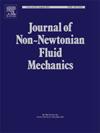The motion of a self-propelling two-sphere swimmer in a weakly viscoelastic fluid
IF 2.7
2区 工程技术
Q2 MECHANICS
引用次数: 0
Abstract
We study analytically the propulsion of a force- and torque-free swimmer composed of two counterrotating spheres of differing radii through a viscoelastic fluid described by the Giesekus constitutive model. Our analysis includes both swimmers composed of directly touching spheres and those composed of spheres separated by some finite distance. The propulsion speed of the swimmer is calculated by first expanding the equations of motion and the Giesekus constitutive model as a power series in the Weissenberg number, and then using the Lorentz reciprocal theorem to determine the first-order propulsion speed using the known flow fields for rotating and translating two-sphere geometries at zeroth order. We calculate the relative rotation speeds of the two spheres necessary to maintain the torque-free condition, including an approximate correction for fluid elasticity. The impact of the separation distance between the two spheres, the ratio of their radii, and the value of the Giesekus mobility parameter on the propulsion speed are all examined; we find that the propulsion speed of the swimmer is maximized for two touching spheres with a radius ratio of approximately 0.7, with a Giesekus mobility parameter of , corresponding to an Oldroyd-B fluid. We also quantify how increased shear-thinning in the fluid, represented by increasing values of , results in a significant decrease in the swimmer speed. Finally, through calculations of the fluid stresses around the two-sphere swimmer, we demonstrate the development of enhanced hoop stresses around the smaller sphere, which drive the expulsion of stretched fluid behind the smaller sphere and induce motion of the swimmer in the direction of the larger sphere.
弱粘弹性流体中自航双球游泳者的运动
我们通过分析研究了由两个不同半径的对转球体组成的无力和无力矩游泳者在粘弹性流体中的推进问题,粘弹性流体由吉塞克斯构成模型描述。我们的分析既包括由直接接触的球体组成的泳者,也包括由相隔一定距离的球体组成的泳者。计算游泳者的推进速度时,首先将运动方程和吉塞克斯构成模型展开为韦森伯格数的幂级数,然后利用洛伦兹倒易定理,利用已知的旋转和平移双球几何体的零阶流场确定一阶推进速度。我们计算了保持无扭矩条件所需的两个球体的相对旋转速度,包括对流体弹性的近似修正。我们研究了两个球体之间的分离距离、半径比以及吉塞克斯流动参数 α 值对推进速度的影响;我们发现,当两个接触球体的半径比约为 0.7,吉塞克斯流动参数 α=0 时,游泳者的推进速度最大,这与奥尔德罗伊德-B 流体相对应。我们还量化了流体中剪切稀化的增加(α 值增加)如何导致游泳者速度的显著下降。最后,通过计算双球游泳者周围的流体应力,我们证明了较小球体周围增强的箍应力的发展,这种箍应力驱动较小球体后面的拉伸流体排出,并诱导游泳者向较大球体的方向运动。
本文章由计算机程序翻译,如有差异,请以英文原文为准。
求助全文
约1分钟内获得全文
求助全文
来源期刊
CiteScore
5.00
自引率
19.40%
发文量
109
审稿时长
61 days
期刊介绍:
The Journal of Non-Newtonian Fluid Mechanics publishes research on flowing soft matter systems. Submissions in all areas of flowing complex fluids are welcomed, including polymer melts and solutions, suspensions, colloids, surfactant solutions, biological fluids, gels, liquid crystals and granular materials. Flow problems relevant to microfluidics, lab-on-a-chip, nanofluidics, biological flows, geophysical flows, industrial processes and other applications are of interest.
Subjects considered suitable for the journal include the following (not necessarily in order of importance):
Theoretical, computational and experimental studies of naturally or technologically relevant flow problems where the non-Newtonian nature of the fluid is important in determining the character of the flow. We seek in particular studies that lend mechanistic insight into flow behavior in complex fluids or highlight flow phenomena unique to complex fluids. Examples include
Instabilities, unsteady and turbulent or chaotic flow characteristics in non-Newtonian fluids,
Multiphase flows involving complex fluids,
Problems involving transport phenomena such as heat and mass transfer and mixing, to the extent that the non-Newtonian flow behavior is central to the transport phenomena,
Novel flow situations that suggest the need for further theoretical study,
Practical situations of flow that are in need of systematic theoretical and experimental research. Such issues and developments commonly arise, for example, in the polymer processing, petroleum, pharmaceutical, biomedical and consumer product industries.

 求助内容:
求助内容: 应助结果提醒方式:
应助结果提醒方式:


